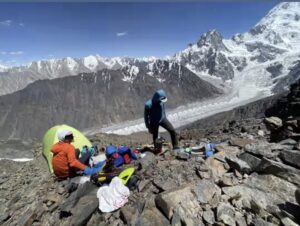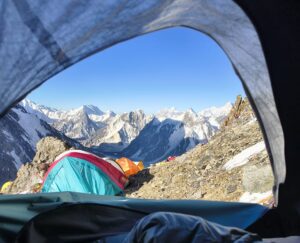Spanish climber and 14×8,000m summiter Ferran Latorre describes the route up 8,080m Gasherbrum I, the 11th highest peak on Earth.
Also known as Hidden Peak and originally identified as K5 by British surveyors in 1856, Gasherbrum I is the highest point of the seven peaks in Gasherbrum Massif. At 8,080m, it is the 11th highest peak in the world.

Gasherbrum I and the glacier at its feet. Photo: Ferran Latorre
Gasherbrum I was the first 8,000m peak whose initial ascent was done alpine style, by Americans Pete Schoening and Andy Kauffman. And yet it is not among the most popular of the 14 big ones. Local outfitters estimate some 200 successful summits to date. That’s one-third the average number of Everest summits in just one season.
After all, the “beautiful peak” (a rough translation of its Balti name) lies in the wild heart of the Karakorum. It requires a very long approach by foot and has fewer civilized resources than peaks in Nepal. Moreover, many of those ready to trek all the way to Base Camp prefer to direct their efforts to the neighboring and easier Gasherbrum II, the only other 8,000m peak in the Gasherbrum massif.
Gasherbrum I is tough from bottom to top but especially on its upper slopes. “That’s why it’s so rewarding,” says 14x8000m climber Ferran Latorre. The Spaniard spoke to ExplorersWeb from the terrace of the Tete Rouge refuge, in between guiding clients on Mont Blanc.

Snow slopes mid-route. Photo: Ferran Latorre
“It’s one of my favorite 8,000’ers,” said Latorre.
After a first attempt with some friends in 1999, Latorre finally summited Gasherbrum I in 2015, along with Yannick Graziani and Tom Seidensticker. They didn’t use O2, and on the 2015 climb, they were alone on the mountain. No fixed ropes, no crowds, no other company.
In fact, Latorre has only used oxygen on Everest. He has climbed exclusively in independent groups, even when he was filming for a Spanish TV series. “Except for Lhotse and Everest, I have not been on a crowded 8,000’er,” he told ExplorersWeb.

Left to right, Ferran Latorre, Yannick Graziani, and Tom Seidensticker on the approach trek to Gasherbrum I in 2015. Photo: Ferran Latorre
The route: Base Camp (5,000m) to Camp 1
Gasherbrums I and II share the same Base Camp. They also have a common Camp 1, which is located not on a mountain face, but on the glacier at its base.

On the glacier toward Camp 1, shared by the normal routes on GI (middle) and GII (the pyramid on the right). Photo: Ferran Latorre
As many climbers have mentioned and Latorre confirms, the glacier has changed over the years. “At first, the glacier is totally flat, so it’s easy to traverse. But in recent years, there are more crevasses to pay attention to,” said Latorre. “For that reason, the route takes longer to cover, because climbers need to pick their way through the crevasses.
“While descending back to Camp 1, Yannick [Graziani] fell in a crevasse, and another French climber died in a crevasse fall in 2007 between C1 and C2. So indeed, it’s a tricky section that requires all our attention.”

Camp 1 on the Gasherbrums’ glacier, right at the foot of GII, with Gasherbrum I behind. Photo: Ferran Latorre
Camp 1 (6,000m) to Camp 2 (6,500m)
Gasherbrum La, the col separating both Gasherbrums, is the reference to aim for when heading to Camp 2. However, the tents are pitched below, at the bottom of the so-called Japanese Couloir. “There’s about one hour to go from Camp 1 to the actual col,” Latorre said.

The Japanese Couloir. Photo: Ferran Latorre
As in the previous section, crevasses are much more abundant here in recent years. “Especially near the col, where the glacier breaks,” he said. “It’s also steeper. Back in 1999, we would walk up in quite a relaxed way. In 2015, we definitely needed to rope up and watch our step.
“You have to cover that section at night or early in the morning when temperatures are lower,” Latorre noted. “This must be taken into account not only on the way up, but especially on the descent when climbers focus on getting back down asap.”

Ferran Latorre in Camp 2. Photo: Ferran Latorre
With or without ropes
“Depending on the year, one may find no ropes or the entire route fixed,” Latorre said. “It all depends on whether there is a big commercial team. In our case, there was another team when we arrived, but they were not so experienced and gave up after the first rotation to Camp 2.

After a snowy night in Camp 2. Photo: Ferran Latorre
Camp 2 to Camp 3 (7,000-7,100m)
“This is probably the most spectacular section of the route, including the Japanese Couloir,” Latorre said. “The route here is confusing. There are several possible variations, and each year teams make their choice according to conditions.”

Latorre’s 2015 route between C2 and C3. Photo: Ferran Latorre
Whichever way you choose, expect exposure and steep terrain, he advised.
“We didn’t go up the Japanese Couloir because there was lots of fresh snow and we knew it can get avalanche-prone. Instead, we followed a line somewhat to the right (first used by a German team in the 1980s), toward a rocky spur.”
The red line on the photo below shows the Japanese Couloir to the left of the route, red, that Latorre and his partners followed.

“From Camp 2, we started up an ice couloir which gets progressively more narrow and steep, until we got to a rocky spur. Here, you have to climb/scramble. On this rather steep terrain, we fixed rope until 7,000m,” said Latorre.
Camp 3 can be at 7,000m, on a platform at the top of the rocky spur, or above at 7,100m, after climbing a 50m-high snow ramp. This leads to a wider and more comfortable campsite on the shoulder.

Camp 3 at 7,000m. Photo Ferran Latorre
Camp 3 at 7,100m lies at the bottom of a snowy cone that will narrow on its way to the summit ridge.
C3 (7,000-7,100m) to Summit (8,080m)
“The final push to the summit is terrible,” Latorre said. “The going gets steeper and steeper until it reaches 50º to 55º right before the final ridge.”
There are several possible passes to the summit ridge. The pace now slows significantly because of altitude and usually lots of snow. “Expect a very long day if there is no trail,” he says.

“The fact that we were all alone there probably had an impact on us too,” he added. “Everything looks serious when you’re up there on your own and there are no fixed ropes.”
Latorre and his partners headed straight for the summit. “Some other climbers tend to look for a saddle to the left of a very characteristic cornice, but that option involves walking longer on the summit ridge. You can do it, but it’s really sharp,” the Catalan climber said.

Approaching the summit ridge. Photo: Ferran Latorre
Compared to GII, Hidden Peak is steeper but it also offers a more direct climb to the summit.
“When we reached the ridge (to the right of the cornice), we found ourselves barely 50m from the highest point,” Latorre said. “But then, the summit ridge is knife-sharp and corniced, with a void on both sides. It’s a real alpine environment at 8,000m and…a simply beautiful way to arrive at the summit.”

Ferran Latorre stands on the summit of Gasherbrum I, on July 24, 2015. Photo: Ferran Latorre
The descent
“Night fell on us shortly after we started down, so the way back to Camp 3 was tricky,” Latorre recalls.
The descent can get dangerous if the snow ramps are icy, although this is not so common. “If you fall, it’s a perfect slide that leads right into a vertical serac — so don’t fall.”
On the following day, they continued down past Camp 2 and all the way to Camp 1. Climbers are tired on the way down and typically climb until late in the day when the sun has weakened the snow bridges over the crevasses. Sure enough, just before Camp 1, Graziani fell into a crevasse.
“That’s why I recommend that teams be extremely careful there,” he said. “It may be better to delay getting back to BC and to spend the night in Camp 2 in order to cross the glacier early.”
Below, a detailed video of Latorre, Graziani, and Seidensticker’s climb of Gasherbrum I.





